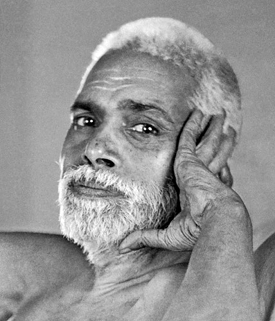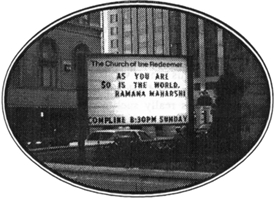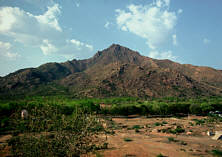Dr. K. Subrahmanian
(1928-1998)
K. Subrahmanian's genuine love and devotion, insight, compassion and selflessness formed a vortex that drew hundreds of devotees from Andhra Pradesh into the shining presence of Sri Ramana Maharshi. In 1979, he founded Sri Ramana Kendram in Hyderabad and continued to nurture it until his final day in January of 1998.
The following is an extract from "Dr.K.Subrahmanian (1928-1998), A Tribute", a book published by the Hyderabad Kendram in his memory. Dr.K.Subrahmanian relates in his own words about his early years and how he was naturally drawn to the Maharshi, and also some anecdotes from his uncle's life.
Coming into the Ramana Fold
Presentation Convent, the school that my father worked for, used to prepare children for taking the Cambridge University examination. The school was run by Irish nuns and almost all the children were European girls. My father was the only male teacher for a number of years. In the 50s, one more male teacher was appointed to teach Hindi.
As the winter vacation was during Dec-Jan every year, my parents would go from Kodaikanal to Tiruvannamalai to attend the Jayanti function. My father used to take English vegetables grown in Kodaikanal to the Ashram for the Jayanti celebrations. After attending the Jayanti, my parents would go to my father's village, Melvayalamoor, which is about 20 miles from Tiruvannamalai. I was taken to Sri Bhagavan when I was two years old. My two younger sisters and I used to be taken almost every year to Sri Ramanasramam for the Jayanti celebrations. In our case we could say we were seen by Sri Bhagavan first. We were conscious of seeing him much later.
My uncle, who looked after our lands in Melva-yalamoor, was also a great devotee of Sri Bhagavan and Nayana [Kavyakanta Ganapati Muni]. Both in my house and in my uncle's house there was always a picture of Sri Bhagavan in the puja room. If not every day, almost every week, there used to be some discussion or the other about the life and teachings of Sri Bhagavan. From childhood I was brought up in a Bhagavan-charged atmosphere.
Viswanatha Swami visited our house and stayed with us for several days together on numerous occasions. Later, when I was teaching at Madras Christian College, he stayed with me a couple of times. He used to spend much of his time talking about the glory and grandeur of Sri Bhagavan and Nayana. He taught us a number of devotional songs. He had a melodious voice and could sing beautifully.
Hearing from my father, uncle and Viswanatha Swami that Sri Bhagavan used to read the letters written by devotees to him, as a boy I used to write to him occasionally, seeking his blessings. As there was no high school in Kodaikanal, my father sent me to study at Sir P. S. Sivaswami Iyer High School, Tirukattupally. I studied there for four years between 1941-45, from III Form to VI Form, and stayed in the hostel attached to it.
Talking to Sri Bhagavan
In 1941, I was taken by my uncle to Sri Ramanasramam. We had bought some mangoes and my uncle said that I should put them on the small stool near Sri Bhagavan's sofa. I went into the old meditation hall along with my uncle and put the mangoes on the floor and prostrated before Sri Bhagavan and sat near the window that now overlooks Sri Bhagavan's samadhi. My uncle sat next to me. When I was looking at Sri Bhagavan, Sri Bhagavan asked my uncle, "Who is this?" My uncle said, "He is my brother's son. He is studying in III Form." Then Sri Bhagavan said, turning to me, " So you are the person writing letters to me." I had a strange feeling of awe, coupled with great joy. I said in a low voice, "Yes." Sri Bhagavan said, "Does your father send money to you so that you can write letters to me?" and laughed. I wasn't quite sure whether Sri Bhagavan was being sarcastic or made the remark in a light vein. I sweated for a while, continuing to look at him. As it was early in the morning, there were only two or three devotees in the hall. When we came out of the hall after some time, my uncle, who had been a frequent visitor to the Ashram for several years, said, "You must consider yourself very lucky. Sri Bhagavan usually does not ask 'Who is he?' It is a rare thing."
Observing Sri Bhagavan
Till 1950, I used to visit the Ashram a couple of times every year; the frequency however increased between 1948 and 1950. I attended the Kumbhabhishekam of the Mathrubhuteswara Temple. It was an elaborate, solemn affair. After the Kumbhabhishekam was performed, in the evening arati was offered to the deity in the temple and was brought to Sri Bhagavan by Chinnaswami, Viswanatha Swami and President Venkataraman. I was sitting very close to Sri Bhagavan in the meditation hall attached to the temple. It was a moving sight when Sri Bhagavan extended his hands and touched the arati with great reverence, closing his eyes.
Soon after each operation was performed on Sri Bhagavan's cancer, I used to visit him. Sometimes I used to cry uncontrollably looking at Sri Bhagavan from a distance. As far as Sri Bhagavan was concerned, he was ever the same serene, blissful Self. He behaved as if the cancer belonged to somebody else.
The last time I saw Sri Bhagavan was on 7th April, 1950, exactly one week before his nirvana. When I heard the news of Sri Bhagavan's nirvana at Kodaikanal, on 14th April, 1950, I did not break down, nor did I feel depressed. I felt a peace — a peace that was totally unexpected. Viswanatha Swami, whom I met a month later, also said that he enjoyed an indescribable peace at the time of Sri Bhagavan's nirvana. He was one of the few who were inside the room at the time Sri Bhagavan merged with Arunachala.
I was taken to Sri Bhagavan as a small boy and I visited him many times later on, but I never put even a single question to him. I listened to others asking questions and Sri Bhagavan's replies to them, but I never felt inclined to ask a question even once. The only thing I used to do was to sit close to him and take leave of him after prostrating to him. Most often he would nod his head or say in Tamiḷ, "sari, sari" (O.K, O.K.).
Occasionally I used to think that it would be good to read Sri Bhagavan's works in his presence. I tried a couple of times but I could not read anything in his presence. I was either looking at him or meditating.
Close Encounters with Sri Bhagavan
Sometime in 1949, when Sri Bhagavan was still in the meditation hall, I sat at the entrance looking at Sri Bhagavan from outside. His shoulder was bandaged because of cancer. I thought to myself: "I have been coming to the Ashram so often. But I have had no experience of real meditation. Sri Bhagavan has not granted me this experience." Thinking along these lines, I kept looking at Sri Bhagavan for a considerable time and then closed my eyes. I do not know how long I was in that state. When I opened my eyes I found that the meditation hall was empty. Sri Bhagavan was not there on the stone couch in the meditation hall. Sri Bhagavan and the devotees must have gone past me as I was sitting at the entrance. When I realised that I had been sitting when Sri Bhagavan went past me, I was horrified. I felt how disrespectful I was. But suddenly, I realised that Sri Bhagavan, out of his unbounded grace, granted me an experience whereby I was completely oblivious of my surroundings.
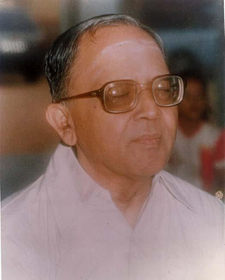
Even today, I am unhappy that I did not get up when Sri Bhagavan and his devotees went past me. Sri Bhagavan gives us rare experiences when we least expect them.
On another occasion, when I was an 18-year-old student, around noon or so, I was walking towards the meditation hall. The new meditation hall was not there then; the whole place was an open ground. I was thinking of something and walking with my head down. When I neared the well, I looked up and saw Sri Bhagavan standing at a short distance and talking to a devotee. I was taken unawares as I did not expect Sri Bhagavan to be there. Sri Bhagavan who was talking to the other person, looked at me sideways. I stood still, as I did not want to disturb Sri Bhagavan in any way. When he looked at me that way, I felt a powerful light penetrate me and engulf me. I experienced a bliss that I had not experienced before. I was in that state for about twenty days.
My uncle, V. S. Srinivas Iyer, did his Intermediate at Voorhese College, Vellore and became village Munsiff of Vailamoor village and worked in that capacity for over forty years. He saw Sri Bhagavan even as a student. In the early days, there used to be very few visitors to the Ashram, which was then just a thatched shed. Before he met Sri Bhagavan, my uncle had come under the influence of Kavyakanta and had taken upadesa from him. This fact is mentioned in the Sanskrit biography of Kavyakanta, Vāsiṣṭha Vaibhavam written by Kapali Sastry.
The first question that my uncle put to Sri Bhagavan as a young man was, "Is it true that Ravana had ten heads." Sri Bhagavan replied, "How does it help you to know whether he had ten heads or not?" My uncle said, "Nayana says it is all false." Sri Bhagavan replied, "Nayana has studied a lot and has come to certain conclusions. What do I know?" On another occasion my uncle asked Sri Bhagavan when he was going round the Hill, "Bhagavan, Nayana did tapas for the freedom of this country. Do you think we will get freedom?" Sri Bhagavan said, "Why do you ask me? Am I an astrologer?" After some time, Sri Bhagavan turned to my uncle and said, " Why do you worry? There is a Supreme Power which carries the whole burden. Our job is to do our work and submit to it."
Once an Ashram deer was attacked by some animal and the wounds turned from bad to worse. Sri Bhagavan sat near the deer and held its face in his hands, looking at its tearful eyes. Sri Bhagavan sat like that for a couple of hours. Chinnaswami asked my uncle who was standing close to look after the deer and relieve Sri Bhagavan. Sri Bhagavan heard this but did not make any response. Sri Bhagavan sat there till the deer breathed its last. That was the compassion that Sri Bhagavan had for that deer. Soon after, Sri Bhagavan went to the hall. There is a Samadhi for the deer in the Ashram.
When the Mathrubhuteswara Temple was being constructed, Sri Bhagavan used to help the construction workers by lifting the bricks and offering them to the mason. When my uncle saw Sri Bhagavan doing this type of work he was astonished. Sri Bhagavan said to my uncle, "I am doing construction work."He said, "It is not for the sake of the husband, my dear, that he is loved, but for one's own sake that he is loved. It is not for the sake of the wife, my dear, that she is loved, but for one's own sake that she is loved. It is not for the sake of the sons, my dear, that they are loved, but for one's own sake that they are loved.... It is not for the sake of all, my dear, that all is loved, but for one's own sake that it is loved. The Self, my dear Maitrey, should be realized, should be heard of, reflected on and meditated upon. When the Self, my dear, is realized by being heard of, reflected on and meditated upon, all this is known."
Ch.IV, verse 6
Advent at Arunachala
New York And Nova Scotia
Nova Scotia, Canada
On Sunday, August 29, 1999, the Nova Scotia Arunachala Ashrama celebrated in the Arunachala Ramana Mandiram the103rd anniversary of Bhagavan's arrival at Sri Arunachala. About thirty devotees arrived the day before the program and many helped with preparations, especially with the cooking of numerous delicious dishes to serve the guests.
Dr. S. Swaminathan performed the worship and conducted the program, which consisted of a puja to Bhagavan, a short talk by Dennis Hartel, group recitations of Bhagavan's works, bhajans and arati. Dr.Swaminathan also gave a lucid and moving account of his three visits to Sri Bhagavan in the 1940s.
A meal was served to all the devotees, as they relaxed amidst the sunny open lawns surrounding the temple. Then an expedition of adventurers, young and old, took to the forest trails and climbed up to our own Virupaksha Cave, which adorns the North Mountain behind the Ashrama.
New York City
Bhagavan's 103rd Advent at Arunachala was celebrated at the New York Ashrama on Sunday, September 5th.
The program began with the recitation of Bhagavan's 108 Names, assisted by the children who placed flowers on Bhagavan's statue and photo as each name was recited. Next, Dennis welcomed the guests and introduced Sri Chinmoy who sang his beautiful Bengali song composed on the Maharshi. An English translation of the song was passed out to all (see below). Sri Chinmoy then read out observations and reflections from his June 1999 visit to Sri Ramanasramam. He had been sincerely moved and inspired by Bhagavan's presence.
Then the highly talented Rajiv Menon sang his rendering of "Dakshinamurti Stotram," along with a few other songs. Other devotees offered songs as well. All devotees joined in with the familiar refrains and lyrics. Everyone recited "Upadesa Saram," and Dr.Wally Shishkov presented Sri Chinmoy with a wooden-mounted painting of Sri Arunachala before the program was concluded with Siva Arati.
After the arati, a delectable assortment of food preparations was served to the full house of guests. And after all had eaten and relaxed, at least half of the devotees gathered again in the shrine room where bhajans and Vedic recitations continued for another hour or two. It was well into the evening before devotees dispersed, reluctant as they were to break the spell of the ever-charming smile, simple-direct teaching and ever-flowing grace of Bhagavan Sri Ramana.My Visit to Sri Ramanasramam
Sri Chinmoy's talk at the N.Y. Arunachala Ashrama on September 5th, 1999
In June this year I was in India for a few days to visit my brother who lives at the Sri Aurobindo Ashram in Pondicherry. On June 9th, I decided to go to Ramana Maharshi's Ashram, which is only two and a half hours away. This was my fourth visit. I went there in 1956, 1958 and again fifteen years ago.
The first thing to greet me when I arrived was a peacock. The peacock was so beautiful. Then I started moving around the Ashram, here and there, taking video and photographs. The entire Ashram was full of peace, peace, peace.
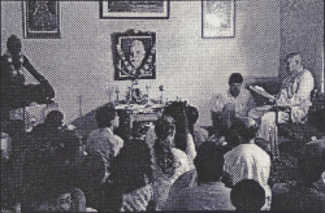
I entered the main meditation hall. The statue of Sri Ramana Maharshi is most sacred. When I first saw this statue of Ramana garlanded in 1956, I felt Ramana Maharshi's living presence inside the statue. This time also, this particular statue was absolutely living. Unfortunately, because of the condition of my knee, I was able to go around the statue only once. Then I sat down to meditate. The atmosphere inside the meditation hall was so sublime.
Afterwards, I wanted to go to the cave where Maharshi actually meditated when he arrived at Arunachala. I was told that it was a forty five minute walk and I could not walk at all. When I went there 15 years ago, I saw the cave and I had a very good experience. But this time it was impossible.
I decided to go and ask the President of the Ashram if it was really such a long walk. The President was not there, but the VicePresident was available. I entered into his office and we began talking and talking. Mani was curious to know if I had known Dilip. We began our conversation with Dilip Kumar Roy, the Golden Voice. I knew him in my adolescent years at the Sri Aurobindo Ashram. So I was able to tell the Vice President many stories about Dilipda and my own personal experiences. He was so pleased to hear them.
Then our marathon conversation touched on South India's greatest poet, Subramaniam Bharati, and also the immortal Sanskrit scholar, T.V. Kapali Sastry, who happened to be my Sanskrit teacher.
The Vice President was extremely, extremely kind to me. He told me his name was Mani, but when I asked him his position, he said, "I am nobody, I am nobody." He was very humble. We spent over an hour together. He repeatedly requested me to stay that night at the Ashram so that I could meet the President the following day, but I could not comply with his loving request.
At one point, Mani asked me, "Was it true that the Mother of the Sri Aurobindo Ashram watched the light?" [The star that appeared and floated slowly across the sky at the moment of the Maharshi's Mahasamadhi].
I said, "It is absolutely true. We were at that time in the playground. I was one of the captains. I was only twenty or thirty meters away from the Mother. As soon as we saw the column of light, the Mother immediately folded her hands and we also folded our hands. We watched the light. It was like a fireball. Then the radio made the announcement that Ramana Maharshi had passed on."
Mani was very, very moved when he heard that the Mother had folded her hands and we all did the same. He was thrilled.
As I was taking my leave of Mani, he asked me, "What do you think of our Ashram?"
I said, "I have been to many spiritual places. I live in America, in New York. In America, sound is sound, and silence is silence. Here, around the temple and in the vicinity of Ramana Maharshi's Ashram, I wish to say that the silence is such a deep silence. But inside the sound also I feel silence."
Mani looked at me. So I added, by way of explanation, "Sound is sound and silence is silence. But here at Ramana Maharshi's place, even in the sound, I feel such peace, such joy. I see men and women passing by, and I see such peace in their faces. There is so much peace. Here in sound also I feel silence." Then he was very, very happy.
On my way back to Pondicherry in the taxi my soul was swimming and swimming in the sea of ecstasy. That is when I had the inspiration to write my song in Bengali about Ramana Maharshi. I translated it into English upon my return to New York.
In July, I had the blessingful opportunity to speak to Mani's brother, Sundaram, on the phone. The President and I had a very illumining conversation about Avatars. I was telling him that each human being is a God-representative, while Avatars like Maharshi Ramana are the direct representatives, supreme representatives, of the Absolute Supreme. We are trying to follow in the footsteps of these mightiest, giant souls who came to earth and whose consciousness is still here on earth and will forever remain here to illumine the world and elevate the consciousness of the world.
My heart is all gratitude to this mightiest soul, Maharshi Ramana. I also wish to offer my deepest gratitude to my esteemed Brother-Friends, Sundaram and Mani, who are now shouldering the responsibility of Maharshi's Ashram.
I am so fortunate to be here with you today on the blessingful anniversary of the Maharshi's arrival at Arunachala and for that I offer my heartfelt gratitude to the genuinely aspiring soul, Dennis, and to all the members of this sacred Ashram.O Great Sage Ramana
and
The perfection-manifestation of the big "I"
(Bengali words, 09 June 1999;
English translation, 12 June 1999)
Letters
"Grace From A Distance"
The article by Elizabeth Lok, entitled "Grace From A Distance," in your Sep/Oct 1999 newsletter, is very moving, particularly when the author refers to Bhagavan's deep brown eyes. It has no rational or scientific explanation, perhaps. We can only say that it is the Maharshi's Grace in action. To those of us who read of the experience, it seems miraculous. To the author, it was revelatory. It seems her heart was so open to the Master that he could not help but respond. I was stirred by this inspiring story and I am grateful that you chose to share it with us. Thank you. Jai Ramana ...Jai, jai, jai... and thank you for your publication. It means so much to me.
Florida
"As you are so is the world"
I was walking by one of the busiest intersections in Toronto when I saw this message in front of The Church of the Redeemer. The next day I returned with my camera and took this photo.
I was very surprised to see this posted in front of a Christian church where thousands of cars and people pass daily. The message was up for the first week of September, 1999.
Toronto
An E-mail
Good morning, My name is Uma Subramanian. We live in Maryland near Washington, D.C. It was by chance that a video cassette of Sri Bhagavan fell into our hands maybe three or four years ago. The first time we saw it, some thing gripped us. The beautiful portrayal, the sensitive narration, left a very indelible impression on my mind. Still for the next year or two, it faded to the back of my mind. But thoughts of Sri Bhagavan were ever with me and I felt like seeing the video again. I borrowed it from our friend, and this time it was a profound experience. Even though I had seen it numerous times before, I was very moved by the experience. I could now identify with the devotees' feeling for Sri Bhagavan, and I was crying most of the time that I was watching it. This led me to get a copy of any book written about Him. Luckily (or it was His grace) I got a copy of Arthur Osborne's book from the bookstore. What can one say about the book? After reading Osborne's book my mind would not accept the other light reading that I normally read. Every time I read it there is something new and I am not bored in spite of re-readings. I think that I've read it more than any text book even. Soon after, I got another book from India called Ramana Arunachala, also by Osborne. Also, I log on to Sri Bhagavan's web site almost every day and it is a joy to read the 'newsletters'.
I would like to get more details about the books that could be purchased from you, and also calendars for the Y2K. Since it is going to be the 50th Mahanirvana year, are you planning something special for the same? Also, do you carry Muruganar's Hymn of Adoration to Sri Bhagavan? I saw that Professor TKS has translated the same into English. It would be great to hear from you.
Uma Sahasram
When I was last at Tiruvannamalai, K. Natesan presented me with Umāsahasram, including Kapali Shastri's Commentary. For some time I have been trying to find someone in Australia capable and interested in translating this important work. Unfortunately I have had no success. As Bhagavan indicated in Suri Nagamma's Letters, he felt as though he had dictated the last 300 verses himself. This alone should be incentive enough —not to mention the great benefit to the devotees of the Divine Mother —to make this project a top priority. I hope you may feel inspired to find a suitable person. Om Ramana
Australia



